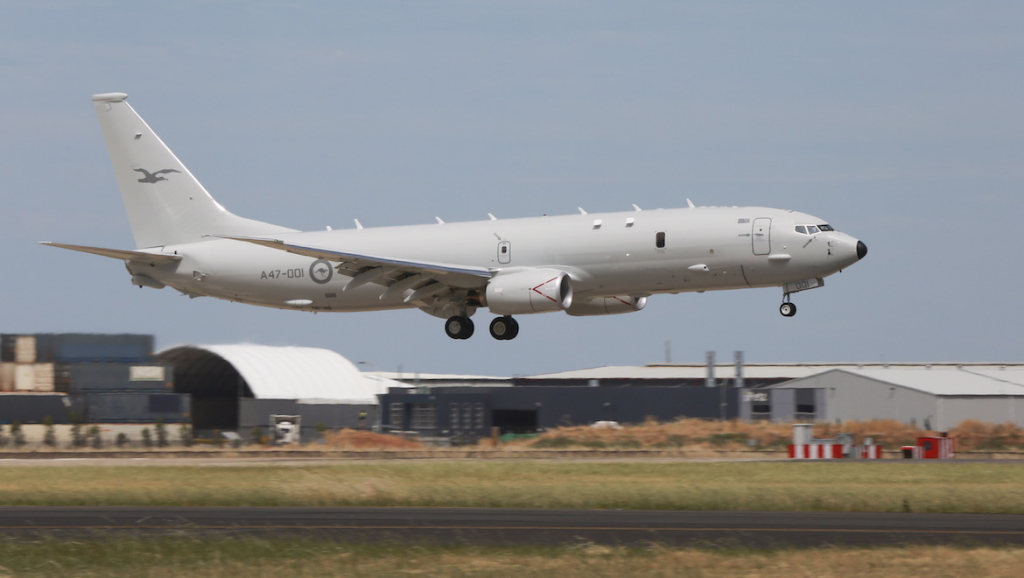
The government has announced it is to purchase an additional two P-8A Poseidons, taking Australia’s total fleet to 14.
Minister for Defence Linda Reynolds said the maritime surveillance aircraft would be purchased as part of the existing “Cooperative Program” agreement with the US Navy.
The P-8A is equipped with advanced sensors and mission systems, including an advanced radar, high-definition cameras, and an acoustic system that is said to have four times the processing capacity of the Orion.
They are designed to replace the RAAF’s AP-3C Orion fleet, together with the MQ-4C Triton unmanned aircraft system.
Minister Reynolds said, “Together, the Poseidon and the Triton will provide Australia with one of the most advanced maritime patrol and response capabilities in the world.
“The Poseidon is a proven capability that will conduct tasks including anti-submarine warfare, maritime and overland intelligence, surveillance and reconnaissance, and support to search and rescue missions.
“These additional aircraft will enhance Air Force’s flexibility to support multiple operations and will play an important role in ensuring Australia’s maritime region is secure for generations to come.”
The purchase forms part of the Morrison’s government’s enlarged $270 billion investment in defence over the next 10 years.
The RAAF accepted its first P-8A after a ceremony at Boeing Field, Seattle.
The news comes shortly after it was announced Australia’s F-35A Lightning II fleet passed the final regulatory hurdle required to be deployed on operations.
Over the coming years, Australia will purchase 72 of the advanced fifth-generation fighter aircraft as part of the $17 billion AIR 6000 Phase 2A/B program – which is aimed at replacing the ageing F/A-18A/B Classic Hornets that have been in service with the RAAF since 1985.
The F-35A – the variant chosen by the RAAF – will have with a projected life of 30 years in service and be based at RAAF Base Williamtown and Base Tindal.
















Pat O'Reilly
says:This commentary is valid for RAAF but is equally relevant to Navy and Army staff.
The DFRDB retirement and pension scheme allowed service personnel to leave the Defence Force after 20 years service. They would then receive payments of an amount determined by how much they had contributed and their rank at discharge.
This scheme effectively encouraged members to discharge after 20 years service and most did leave around then. They moved into the civilian world with their age around the mid to late 30s and usually, using their military training, began a new career thereby benefiting the community as a whole.
This was a knock on benefit but the real benefit for defence was that there was continuous replacement required for these discharged people. When the 20 year Flight Sergeant left a Sergeant was promoted to fill his spot. A Corporal was then promoted to fill the Sergeants position, an LAC was promoted to the Corporal’s spot and recruiting continuously organised new replacements via the training schools.
This system has worked well since at least the 1960s but has now been replaced with a system which does not encourage senior staff to leave. They now stay in the service until they are ready to age retire into the civilian world. Their expertise is lost to the community.
This is having a disastrous effect on current expertise levels, particularly in the aircraft technical trades. Because discharges have dried up there is no promotion for the younger up and coming trade qualified personnel. As military pay (and therefore retirement pension) is based upon the person’s rank and there are no promotions, they miss out on pay rises. The highly trained, highly qualified, tradespersons are leaving in droves. These are the tech’s with 6 to 10 years expertise in their fields. They are the vital experienced staff that need to be retained, but they discharge seeking job satisfaction, pay rises and careers where they feel rewarded for effort.
The problem is not going away. It has been recognised and the RAAF is fiddling at the edges trying to create vacancies but it is far too little and their hands are tied by the current pension scheme. That scheme needs to be modified to encourage senior staff turnover to allow the retention of the desirable work force.
Gary Smith
says:What has this got to do with the addition of 2 x P8s?
Gary Smith
says:What has this got to do with P8s? As you mention the DFRDB, the ‘System’ you are talking about I presume is MSBS which replaced DFRDB in 1989. MSBS has since been replaced by ADF Super in 2016.
Craig Beatty
says:It was previously announced 3 more were going to be procured. Does that mean one more to come?
Gary Smith
says:Not likely. The three you mention were only options with the requirement that these need to be exercised by the end of 2020.
Ben
says:The 2016 White Paper projected that 15 would be in service by the late 2020s. It wasn’t a firm order.
Rocket
says:The F-35A is not replacing the F/A-18A/B, it was initially purchased to replace both it and the General Dynamics F-111……. which was laughingly ‘replaced’ by the extremely short range F/A-18F Super Hornet.
It is both a fighter and strike aircraft so it does the job of both the F/A-18s and the F-111C/F-111G.
As for ‘ageing’, everything is ‘ageing’ the moment it is built, so that’s just a favourite ‘media’ word.
jsjjf
says:$270 Billion? What budget deficit? Or are we selling off the last few public assets?
Derrick Aguero
says:@CRAIG BEATTY, I believe the original plan was for 15 airframes (1 option left) with 4 MQ-4C Triton, but the government has approved another 2 more MQ-4C bring the total to 6